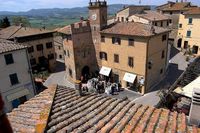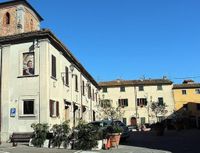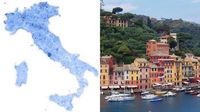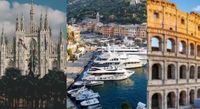In a remarkable display of wealth concentration, the latest income rankings for Italian municipalities reveal that Lajatico, a small town in the province of Pisa, has secured its place as the second richest town in Italy. This accolade comes just behind Portofino, which boasts the highest per capita income in the country. The data, released on April 18, 2025, by the Ministry of Economy and Finance, is based on 2023 income tax returns filed in 2024, and it highlights the profound impact of notable residents on local economies.
Portofino, located in the province of Genoa, leads the pack with an impressive average income of €94,505. This figure has seen a bump of around €4,000 from the previous year, largely attributed to the residency of Pier Silvio Berlusconi, who has moved significant assets and income to this picturesque coastal town. Berlusconi's presence has undoubtedly influenced Portofino's economic landscape, allowing it to maintain its status as the wealthiest municipality for the second consecutive year.
Following Portofino, Lajatico's average income stands at €61,980, a remarkable figure that has increased by 10.2% compared to 2022. The driving force behind Lajatico's economic success is none other than Andrea Bocelli, the world-renowned tenor who calls the town home. Bocelli's celebrity status and the activities associated with his career have had a significant positive impact on the local economy, propelling Lajatico ahead of larger metropolitan areas.
In fact, the income level in Lajatico showcases how even small towns can flourish economically when bolstered by prominent figures. Bocelli's influence is so substantial that it elevates the average income of Lajatico above many larger cities, including Milan, which ranks eighth in the national standings with an average income of over €38,000.
Completing the top three is Basiglio, a town near Milan, with an average income of €50,807. Interestingly, this marks a decline of 5.5% from the previous year, suggesting that the economic dynamics in the area are shifting. Meanwhile, a newcomer to the rankings, Solonghello, has made a surprising entry into the top ten with a per capita income of €46,583, reflecting a staggering 47% increase, likely fueled by investments from affluent outsiders.
The national average per capita income in Italy is reported at €22,743, which represents a 4.6% increase compared to last year. However, this growth is tempered by a rising inflation rate of 5.7%, which has effectively eroded the real income gains for many households. The disparities in income across regions are stark, with Lombardy leading the way with an average income of €26,734, while regions like Calabria lag behind at €17,064.
When looking at the broader picture, the data reveals that 78% of taxpayers in Italy declare incomes below €35,000. This statistic underscores the significant economic divide within the country, as a small percentage of high earners, referred to as "Paperoni," who earn over €300,000, account for a disproportionate share of the total tax revenue.
In Tuscany, Lajatico's rise to prominence is a testament to the potential for small communities to thrive amid larger economic forces. The town's growth, driven by Bocelli's fame, serves as a model for how individual contributions can reshape local economies. With its rich cultural heritage and scenic beauty, Lajatico continues to attract attention, not just for its wealth but for its unique identity.
In contrast, the poorest town in Tuscany, Roccalbegna, highlights the other end of the economic spectrum, with an average income of just €16,400. This stark contrast serves as a reminder of the economic challenges facing many regions in Italy, particularly in the south, where income levels often fall below €15,000.
As the income rankings continue to evolve, the influence of high-profile residents like Bocelli and Berlusconi will likely remain a critical factor in shaping the economic landscape of Italian municipalities. The interplay between celebrity culture and local economies raises intriguing questions about the future of wealth distribution in the country.
In conclusion, the latest income rankings reveal a fascinating dynamic in Italy's economic landscape, where small towns can rival major cities in wealth due to the presence of influential figures. As Lajatico and Portofino showcase, the impact of individual residents can significantly alter the economic fortunes of a community, prompting discussions about the broader implications for income inequality and regional development.









